Ford-Fulkerson算法是一种贪婪方法,用于计算网络或图形中的最大可能流量。
术语流动网络用于描述具有源(S)和宿(T)的顶点和边的网络。除了S和T之外,每个顶点都可以通过它接收和发送相等数量的东西。 S只能发送,而T只能接收东西。
我们可以使用不同容量的管网内部的液体流动来可视化对算法的理解。每个管道在特定情况下都可以传输一定容量的液体。对于此算法,我们将发现在使用网络的情况下,有多少液体可以从源流到汇。
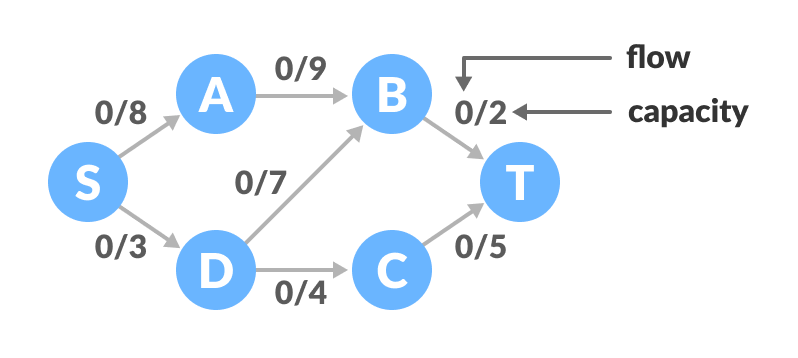
使用的术语
增强路径
它是流网络中可用的路径。
残差图
它表示具有其他可能流量的流量网络。
剩余容量
从最大容量中减去流量后的边缘容量。
Ford-Fulkerson算法如何工作?
该算法如下:
- 将所有边中的流初始化为0。
- 当源和接收器之间存在增加路径时,将此路径添加到流中。
- 更新残差图。
如果需要,我们还可以考虑反向路径,因为如果不考虑反向路径,则可能永远找不到最大流量。
通过以下示例可以理解上述概念。
福特福克森的例子
开始时所有边的流为0。
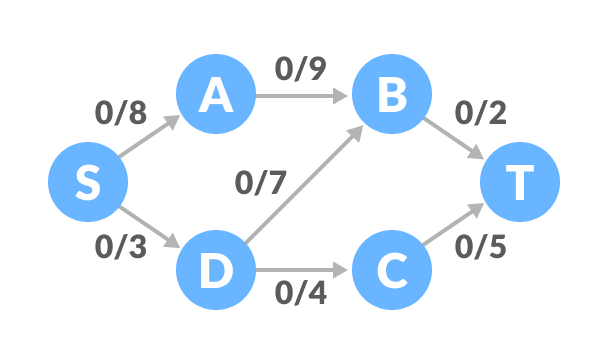
- 选择从S到T的任意路径。在此步骤中,我们选择了路径SABT 。
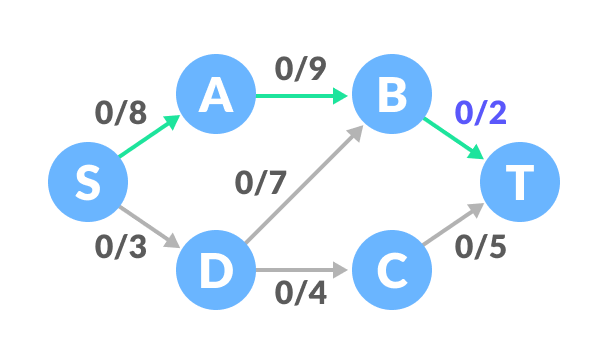
寻找道路 三个边缘之间的最小容量为2( BT )。基于此,更新每个路径的流量/容量 。
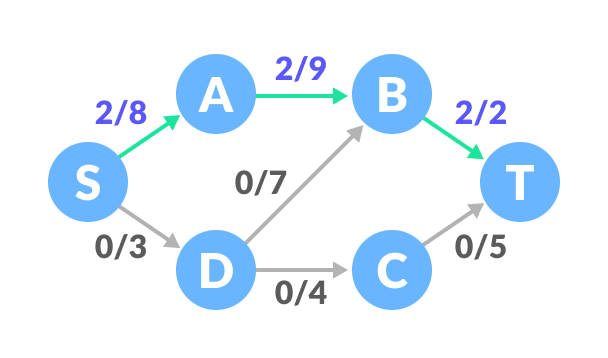
更新容量 - 选择另一条路径SDCT 。这些边的最小容量为3( SD )。
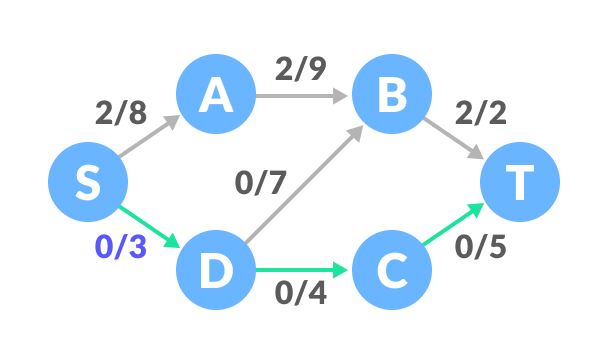
寻找下一条路 根据此更新容量。
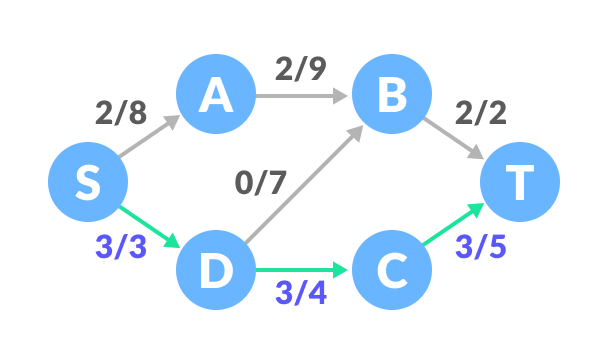
更新容量 - 现在,让我们也考虑反向路径BD 。选择路径SABDCT 。边缘之间的最小剩余容量为1( DC )。

寻找下一条路 更新容量。
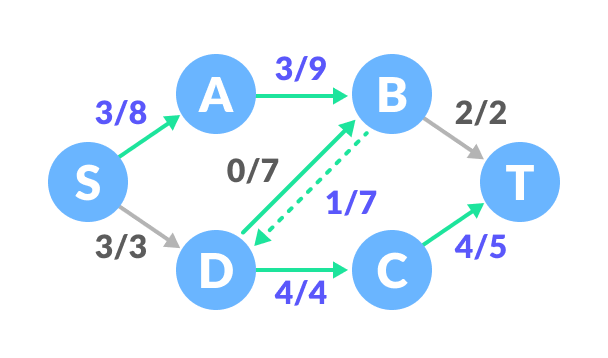
更新容量 正向和反向路径的容量分别考虑。
- 将所有流量相加= 2 + 3 + 1 = 6,这是流量网络上的最大可能流量。
请注意,如果任何边缘的容量已满,则无法使用该路径。
Python,Java和C / C++示例
Python
爪哇
C
C++
# Ford-Fulkerson algorith in Python
from collections import defaultdict
class Graph:
def __init__(self, graph):
self.graph = graph
self. ROW = len(graph)
# Using BFS as a searching algorithm
def searching_algo_BFS(self, s, t, parent):
visited = [False] * (self.ROW)
queue = []
queue.append(s)
visited[s] = True
while queue:
u = queue.pop(0)
for ind, val in enumerate(self.graph[u]):
if visited[ind] == False and val > 0:
queue.append(ind)
visited[ind] = True
parent[ind] = u
return True if visited[t] else False
# Applying fordfulkerson algorithm
def ford_fulkerson(self, source, sink):
parent = [-1] * (self.ROW)
max_flow = 0
while self.searching_algo_BFS(source, sink, parent):
path_flow = float("Inf")
s = sink
while(s != source):
path_flow = min(path_flow, self.graph[parent[s]][s])
s = parent[s]
# Adding the path flows
max_flow += path_flow
# Updating the residual values of edges
v = sink
while(v != source):
u = parent[v]
self.graph[u][v] -= path_flow
self.graph[v][u] += path_flow
v = parent[v]
return max_flow
graph = [[0, 8, 0, 0, 3, 0],
[0, 0, 9, 0, 0, 0],
[0, 0, 0, 0, 7, 2],
[0, 0, 0, 0, 0, 5],
[0, 0, 7, 4, 0, 0],
[0, 0, 0, 0, 0, 0]]
g = Graph(graph)
source = 0
sink = 5
print("Max Flow: %d " % g.ford_fulkerson(source, sink))// Ford-Fulkerson algorith in Java
import java.util.LinkedList;
class FordFulkerson {
static final int V = 6;
// Using BFS as a searching algorithm
boolean bfs(int Graph[][], int s, int t, int p[]) {
boolean visited[] = new boolean[V];
for (int i = 0; i < V; ++i)
visited[i] = false;
LinkedList queue = new LinkedList();
queue.add(s);
visited[s] = true;
p[s] = -1;
while (queue.size() != 0) {
int u = queue.poll();
for (int v = 0; v < V; v++) {
if (visited[v] == false && Graph[u][v] > 0) {
queue.add(v);
p[v] = u;
visited[v] = true;
}
}
}
return (visited[t] == true);
}
// Applying fordfulkerson algorithm
int fordFulkerson(int graph[][], int s, int t) {
int u, v;
int Graph[][] = new int[V][V];
for (u = 0; u < V; u++)
for (v = 0; v < V; v++)
Graph[u][v] = graph[u][v];
int p[] = new int[V];
int max_flow = 0;
# Updating the residual calues of edges
while (bfs(Graph, s, t, p)) {
int path_flow = Integer.MAX_VALUE;
for (v = t; v != s; v = p[v]) {
u = p[v];
path_flow = Math.min(path_flow, Graph[u][v]);
}
for (v = t; v != s; v = p[v]) {
u = p[v];
Graph[u][v] -= path_flow;
Graph[v][u] += path_flow;
}
// Adding the path flows
max_flow += path_flow;
}
return max_flow;
}
public static void main(String[] args) throws java.lang.Exception {
int graph[][] = new int[][] { { 0, 8, 0, 0, 3, 0 }, { 0, 0, 9, 0, 0, 0 }, { 0, 0, 0, 0, 7, 2 },
{ 0, 0, 0, 0, 0, 5 }, { 0, 0, 7, 4, 0, 0 }, { 0, 0, 0, 0, 0, 0 } };
FordFulkerson m = new FordFulkerson();
System.out.println("Max Flow: " + m.fordFulkerson(graph, 0, 5));
}
} / Ford - Fulkerson algorith in C
#include
#define A 0
#define B 1
#define C 2
#define MAX_NODES 1000
#define O 1000000000
int n;
int e;
int capacity[MAX_NODES][MAX_NODES];
int flow[MAX_NODES][MAX_NODES];
int color[MAX_NODES];
int pred[MAX_NODES];
int min(int x, int y) {
return x < y ? x : y;
}
int head, tail;
int q[MAX_NODES + 2];
void enqueue(int x) {
q[tail] = x;
tail++;
color[x] = B;
}
int dequeue() {
int x = q[head];
head++;
color[x] = C;
return x;
}
// Using BFS as a searching algorithm
int bfs(int start, int target) {
int u, v;
for (u = 0; u < n; u++) {
color[u] = A;
}
head = tail = 0;
enqueue(start);
pred[start] = -1;
while (head != tail) {
u = dequeue();
for (v = 0; v < n; v++) {
if (color[v] == A && capacity[u][v] - flow[u][v] > 0) {
enqueue(v);
pred[v] = u;
}
}
}
return color[target] == C;
}
// Applying fordfulkerson algorithm
int fordFulkerson(int source, int sink) {
int i, j, u;
int max_flow = 0;
for (i = 0; i < n; i++) {
for (j = 0; j < n; j++) {
flow[i][j] = 0;
}
}
// Updating the residual values of edges
while (bfs(source, sink)) {
int increment = O;
for (u = n - 1; pred[u] >= 0; u = pred[u]) {
increment = min(increment, capacity[pred[u]][u] - flow[pred[u]][u]);
}
for (u = n - 1; pred[u] >= 0; u = pred[u]) {
flow[pred[u]][u] += increment;
flow[u][pred[u]] -= increment;
}
// Adding the path flows
max_flow += increment;
}
return max_flow;
}
int main() {
for (int i = 0; i < n; i++) {
for (int j = 0; j < n; j++) {
capacity[i][j] = 0;
}
}
n = 6;
e = 7;
capacity[0][1] = 8;
capacity[0][4] = 3;
capacity[1][2] = 9;
capacity[2][4] = 7;
capacity[2][5] = 2;
capacity[3][5] = 5;
capacity[4][2] = 7;
capacity[4][3] = 4;
int s = 0, t = 5;
printf("Max Flow: %d\n", fordFulkerson(s, t));
} // Ford-Fulkerson algorith in C++
#include
#include
#include
#include
using namespace std;
#define V 6
// Using BFS as a searching algorithm
bool bfs(int rGraph[V][V], int s, int t, int parent[]) {
bool visited[V];
memset(visited, 0, sizeof(visited));
queue q;
q.push(s);
visited[s] = true;
parent[s] = -1;
while (!q.empty()) {
int u = q.front();
q.pop();
for (int v = 0; v < V; v++) {
if (visited[v] == false && rGraph[u][v] > 0) {
q.push(v);
parent[v] = u;
visited[v] = true;
}
}
}
return (visited[t] == true);
}
// Applying fordfulkerson algorithm
int fordFulkerson(int graph[V][V], int s, int t) {
int u, v;
int rGraph[V][V];
for (u = 0; u < V; u++)
for (v = 0; v < V; v++)
rGraph[u][v] = graph[u][v];
int parent[V];
int max_flow = 0;
// Updating the residual values of edges
while (bfs(rGraph, s, t, parent)) {
int path_flow = INT_MAX;
for (v = t; v != s; v = parent[v]) {
u = parent[v];
path_flow = min(path_flow, rGraph[u][v]);
}
for (v = t; v != s; v = parent[v]) {
u = parent[v];
rGraph[u][v] -= path_flow;
rGraph[v][u] += path_flow;
}
// Adding the path flows
max_flow += path_flow;
}
return max_flow;
}
int main() {
int graph[V][V] = {{0, 8, 0, 0, 3, 0},
{0, 0, 9, 0, 0, 0},
{0, 0, 0, 0, 7, 2},
{0, 0, 0, 0, 0, 5},
{0, 0, 7, 4, 0, 0},
{0, 0, 0, 0, 0, 0}};
cout << "Max Flow: " << fordFulkerson(graph, 0, 5) << endl;
} 福特福克森应用
- 输水管道
- 二分匹配问题
- 按需流通